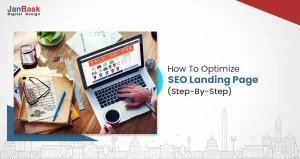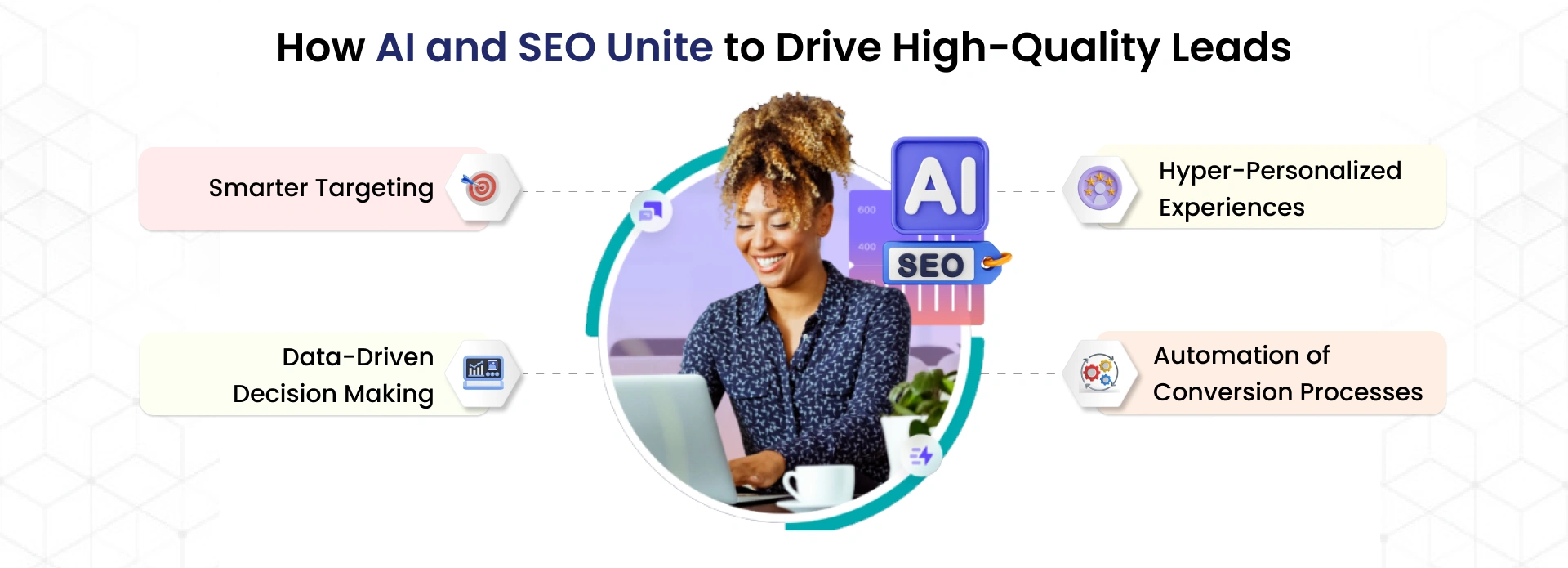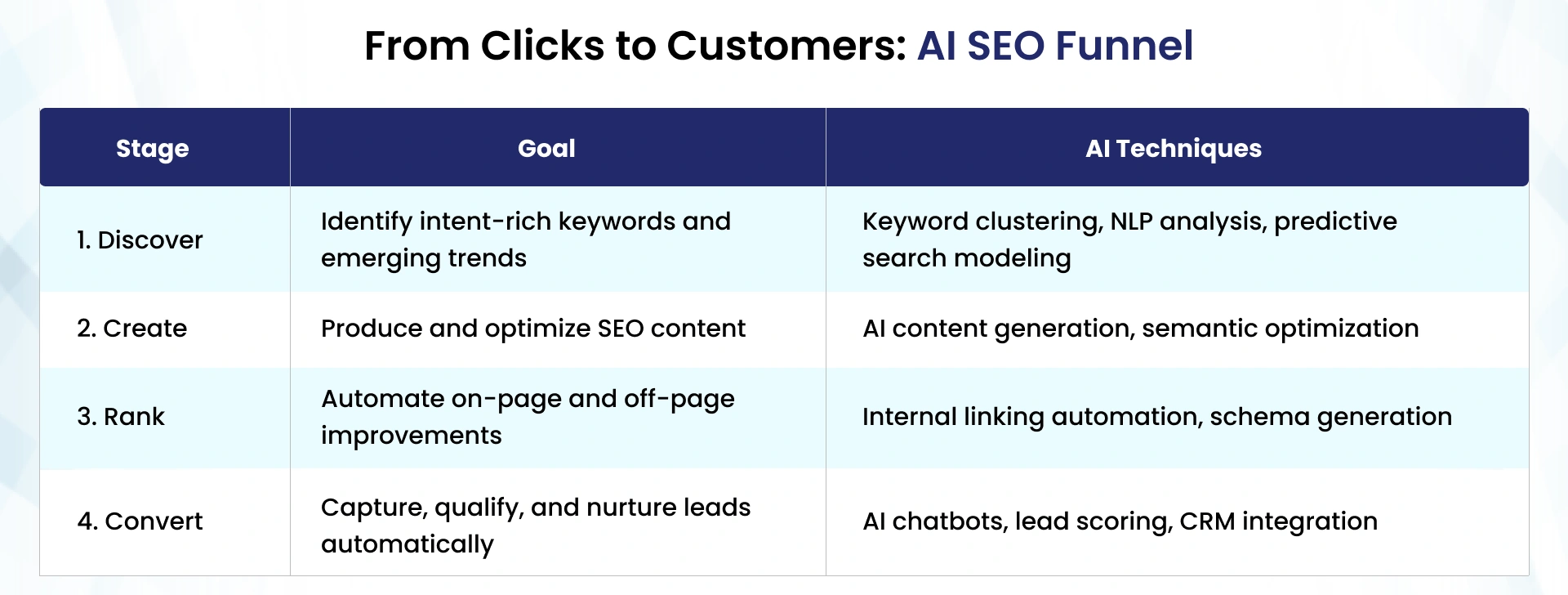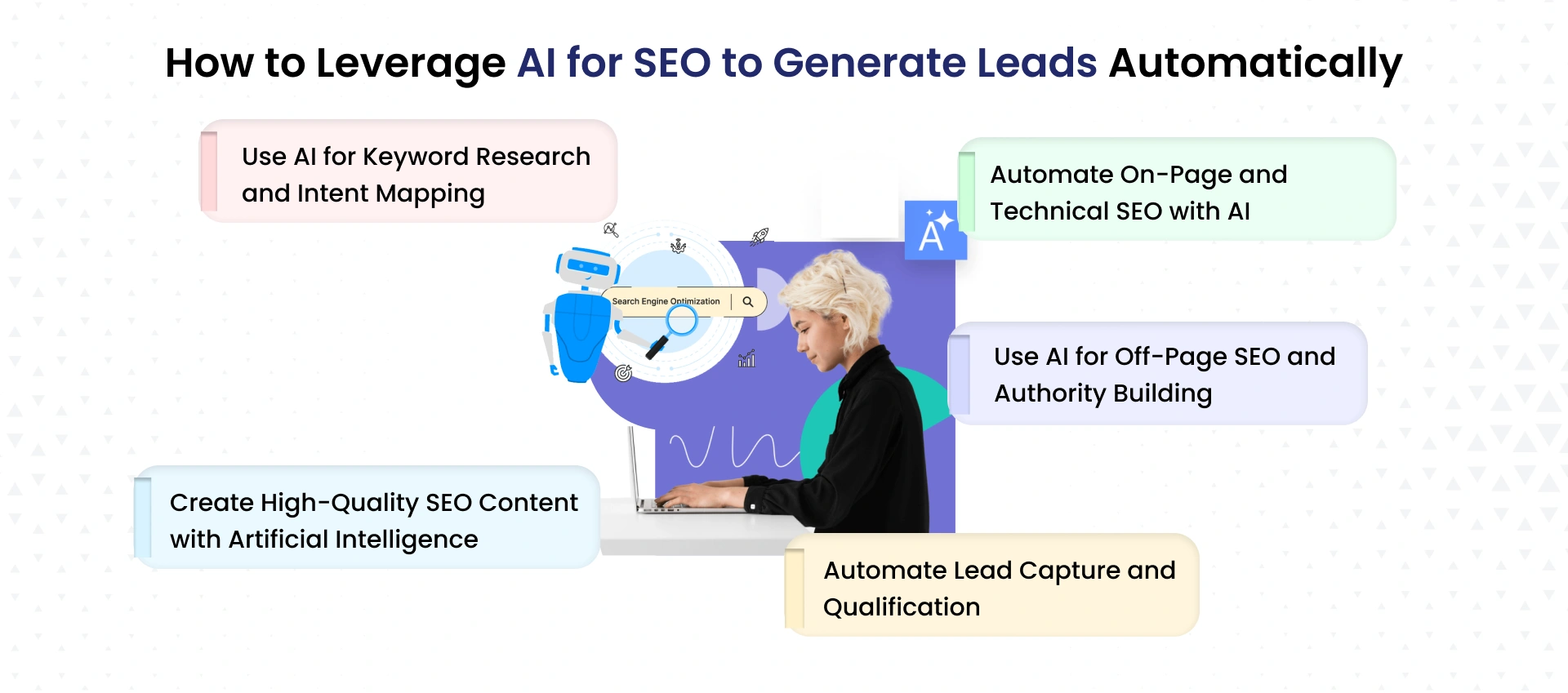
Search engine optimization has always been at the heart of digital marketing. But as competition intensifies and algorithms evolve, traditional SEO methods — manual keyword research, human-written meta tags, and static content — are no longer enough. Enter AI for SEO, a transformative approach that leverages artificial intelligence to optimize, automate, and scale your entire lead generation process.
In the past, SEO was about driving traffic. Today, with AI SEO, the goal has shifted toward attracting the right kind of traffic — visitors who are more likely to convert into paying customers. AI makes this possible by understanding user intent, predicting behavior, and automatically optimizing every stage of the customer journey.
Whether you’re running an eCommerce brand, a B2B SaaS company, or website design and SEO services, AI can streamline how you generate leads — from identifying high-intent keywords to nurturing prospects automatically. Let’s explore exactly how.
AI in SEO refers to the use of artificial intelligence, machine learning, and natural language processing (NLP) to analyze search data, optimize content, and improve rankings more efficiently than traditional methods.
Search engines themselves now rely heavily on AI — think of Google’s RankBrain, BERT, and Gemini models — to understand context, relevance, and user intent behind every query. So, if you want your content to rank well, your SEO strategy needs to align with how AI interprets information.
In the past, SEO was largely a game of trial and error — marketers would optimize content, track rankings, and hope for the best. Today, artificial intelligence is transforming this process, making SEO smarter, faster, and far more precise. AI doesn’t just react to search trends; it predicts them, interprets user intent, and fine-tunes content for maximum impact. By leveraging machine learning, natural language processing, and data analytics, AI enables marketers to optimize at scale while maintaining a personal touch. Here’s how AI enhances traditional SEO practices:

AI can analyze millions of search patterns and forecast future keyword trends. This helps you stay ahead of competitors instead of reacting to them.
Tools powered by NLP can interpret user questions and optimize your content so that it directly answers what people are really asking.
AI can evaluate readability, keyword density, tone, and even emotional engagement, providing actionable recommendations to improve content quality.
From adjusting meta tags to generating alt text and schema markup, AI can automate many repetitive SEO tasks.
AI continuously monitors your rankings, backlinks, and engagement metrics, suggesting improvements in real time.
Essentially, AI SEO allows marketers to operate with a level of precision and personalization that was previously impossible — transforming SEO from an art of intuition into a science of prediction and automation.
The relationship between SEO and AI is symbiotic. SEO builds the visibility and discoverability of your brand, while AI ensures that this visibility attracts the right audience — those most likely to convert.
Imagine this process as a continuous loop: SEO drives traffic → AI analyzes behavior → AI optimizes targeting → SEO rankings improve → more qualified leads arrive.

Here’s how this partnership works in practice:
The outcome? A self-optimizing SEO system that generates high-quality business leads automatically, reducing manual effort while boosting conversion rates.
To really understand how Artificial Intelligence (AI) turns SEO into a powerful tool for generating business leads, it’s helpful to imagine the entire process as a funnel that moves step by step. This funnel has four clear stages, and at each stage, AI plays a unique role. Just like how a funnel guides water smoothly into a bottle, AI helps guide potential customers through different steps — from discovering your business online to becoming actual leads who are ready to take action. By breaking it down into these stages, it becomes much easier to see how AI makes the entire SEO process smarter, faster, and more effective.

Each stage feeds the next, creating a closed loop where data, performance, and automation continuously refine one another.
Now, let’s get practical. AI can simplify every step of your SEO, from finding the right keywords to optimizing content and tracking results. It helps you work smarter, save time, and turn traffic into leads.
Here’s a step-by-step guide to using AI SEO effectively — from research to generating qualified leads.

Keyword research has evolved beyond identifying terms with high volume. In the era of AI SEO, success lies in understanding intent. AI tools can analyze millions of search queries, cluster related topics, and identify which phrases carry commercial or transactional intent.
This approach ensures that you’re not just targeting traffic, but attracting visitors who are genuinely interested in your solutions — which directly improves lead quality.
Once you’ve identified keywords that match user intent, the next important step is creating high-quality content. AI plays a powerful role here. It doesn’t just make the writing process quicker; it makes it more intelligent. AI helps structure your content, improve clarity, suggest better wording, and ensure it connects with your target audience.
High-performing content should inform, engage, and subtly guide the reader toward conversion. When done right, artificial intelligence SEO enables you to produce authoritative, optimized, and conversion-focused content at scale — while maintaining human nuance.
Manually optimizing your website for every single update can be time-consuming and exhausting. This is where AI becomes a game changer. It automates routine, repetitive tasks like tracking changes, updating content, and improving technical elements. At the same time, it constantly analyzes performance and makes smart adjustments, keeping your site optimized effortlessly.
By implementing these automations, you maintain a technically sound website that’s optimized for both humans and AI search algorithms — ensuring consistent ranking and traffic.
Off-page SEO — especially link building — is another area where AI excels. Instead of manually identifying outreach opportunities, AI tools analyze backlink profiles and generate outreach lists automatically.
When combined with a strong on-page foundation, these AI-driven off-page efforts amplify your SEO impact and help attract higher-quality organic leads.
Bringing visitors to your website is just the first step; the real success comes from turning those visitors into potential customers. That’s where the real challenge lies. AI-powered SEO goes beyond just attracting traffic — it helps understand user behavior, personalize their experience, and guide them toward taking action, making lead generation easier and more effective.
For businesses offering website design and SEO services, these tools can transform how leads are captured and managed — replacing manual follow-ups with real-time AI-driven engagement that operates 24/7.
As search engines themselves become increasingly AI-driven, optimizing your site for AI visibility is just as important as optimizing it for humans. Here are essential best practices for SEO enhancing AI visibility:

Search algorithms now evaluate not just what you say, but who says it. Use author bios, credentials, and testimonials to build trust.
Implement schema to help AI understand your page’s content. This can improve your visibility in AI-powered search features like rich snippets and voice results.
AI algorithms assess semantic meaning, so optimize for topics and intent clusters instead of obsessing over exact-match keywords.
AI systems reward sites that consistently update and expand their content. Use AI audit tools to identify outdated information and refresh it regularly.
AI can optimize structure and predict trends, but authentic storytelling and emotion still resonate best with human audiences. Use both to your advantage.
Following these best practices helps your content become not only discoverable but also interpretable and favored by AI-powered search systems — a critical factor in modern SEO success.
Even experienced marketers can make mistakes when applying AI SEO strategies. These errors can lead to wasted time, unnecessary expenses, and even harm a brand’s image. By being aware of common pitfalls early on and avoiding them, businesses can protect their resources, maintain credibility, and get the best possible results from their AI SEO efforts.
AI tools can create impressive drafts, but they often lack nuance, originality, and emotional depth. Always review, edit, and refine AI-generated content before publishing.
AI might optimize for algorithms, but real leads come from real people. Balance automation with empathy and human-centric storytelling.
No amount of AI can compensate for a slow website, broken links, or poor UX. Ensure your site’s structure and speed are optimized before scaling automation.
AI SEO performs best when connected to analytics and CRM systems. Integrate tools like Google Analytics, HubSpot, and Zapier to create seamless data flow.
Set clear KPIs — such as organic traffic, conversion rates, and cost per lead — to evaluate your AI SEO strategy’s performance.
By staying aware of these challenges, you ensure your AI-driven SEO approach remains effective, ethical, and customer-focused.
If you want to turn your marketing funnel into a fully automated lead generation machine, it’s important to follow a clear, step-by-step plan. This actionable roadmap will guide you through each stage, showing how to leverage AI, optimize processes, and systematically attract, engage, and convert prospects into high-quality leads with minimal manual effort.
This step-by-step system allows you to move from passive SEO visibility to active, automated lead generation.
The fusion of AI and SEO represents a powerful shift in how businesses approach digital marketing. SEO is no longer just about ranking on search engines — it’s about building a smart, adaptive system that consistently attracts, engages, and converts the right audience.
By integrating AI-powered SEO strategies, businesses can accurately predict search trends, craft highly optimized content, automate technical processes, and nurture high-quality leads with minimal manual effort. Whether you’re a growing startup or a well-established brand, embracing AI ensures you stay ahead in a rapidly evolving digital landscape.
At JanBask Digital Design, we help businesses harness the full potential of AI-driven SEO to generate more qualified leads and accelerate growth. The future of lead generation isn’t manual — it’s intelligent, automated, and data-driven. Let AI do the heavy lifting, while your team focuses on strategy, creativity, and closing more deals.
Start Generating High-Quality Leads with AI Now!

Leave a Reply